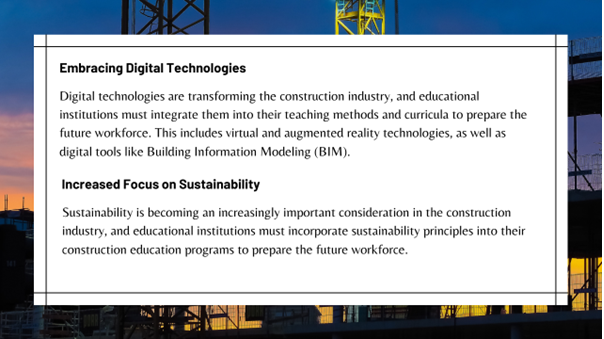
As the construction industry continues to evolve and adopt new technologies, it is important that the education of the industry’s future workforce keeps up. The construction education landscape is changing rapidly, and it is essential for educational institutions and industry organizations to adapt their programs and curricula to meet the needs of the modern construction industry.
In this blog post, we will explore some of the key trends and developments that are shaping the future of construction education.
Trend 1: Embracing Digital Technologies
Digital technologies have been transforming the construction industry in recent years, and this trend is set to continue. To prepare the future workforce for these changes, educational institutions must embrace digital technologies in their teaching methods and curricula.
This includes the use of virtual and augmented reality technologies to simulate construction projects and provide hands-on learning experiences for students. It also involves incorporating digital tools such as Building Information Modeling (BIM) into construction education programs.
Trend 2: Increased Focus on Sustainability
Sustainability is becoming an increasingly important consideration in the construction industry. This trend is reflected in the growing demand for sustainable building materials and practices. To ensure that the future workforce is equipped with the knowledge and skills needed to meet this demand, educational institutions must incorporate sustainability principles into their construction education programs.
This includes teaching students about sustainable building practices, such as green building and passive design, and the use of sustainable building materials. It also involves educating students on the environmental impact of construction activities and how to minimize this impact.
Trend 3: Collaboration and Interdisciplinary Education
Construction projects are becoming increasingly complex and involve multiple stakeholders, from architects and engineers to contractors and project managers. To prepare the future workforce for these collaborative projects, construction education programs must incorporate interdisciplinary education.
This involves providing students with the opportunity to work with professionals from different fields and disciplines, such as architecture, engineering, and project management. It also involves teaching students how to communicate effectively with other professionals and how to work in multidisciplinary teams.

Trend 4: Soft Skills Development
While technical skills are essential in the construction industry, soft skills such as communication, teamwork, and leadership are becoming increasingly important. Educational institutions must incorporate soft skills development into their construction education programs to prepare students for success in the industry.
This includes providing students with opportunities to develop their communication, teamwork, and leadership skills through hands-on learning experiences, such as group projects and internships.
Trend 5: Lifelong Learning
The construction industry is constantly evolving, and it is essential for professionals to stay up-to-date with the latest trends and technologies. Educational institutions must prepare students for a lifelong learning journey by instilling a passion for learning and providing them with the skills and resources needed to continue learning throughout their careers.
This includes teaching students how to access and evaluate information, as well as providing them with opportunities for ongoing professional development.

Trend 6: Remote and Hybrid Learning
The COVID-19 pandemic has accelerated the trend towards remote and hybrid learning in all sectors, including construction education. Educational institutions have had to adapt quickly to provide online and remote learning opportunities for students. The pandemic has also highlighted the importance of technology in construction education. As a result, educational institutions are investing more in technology and online tools to improve the learning experience for students. This includes the use of online learning platforms, video conferencing tools, and remote access to construction software.
Trend 7: Diversity and Inclusion
Diversity and inclusion are becoming increasingly important considerations in the construction industry. A more diverse workforce can bring new perspectives and ideas to the industry, and it can help to address the labour shortages that the industry is facing.
Educational institutions must promote diversity and inclusion in their construction education programs by recruiting and retaining a diverse student body and by providing support for underrepresented groups. This includes offering scholarships and mentorship programs for women, minorities, and other underrepresented groups in the industry.
Conclusion

The future of construction education is exciting, as educational institutions and industry organizations embrace new technologies, sustainability principles, interdisciplinary education, soft skills development, and lifelong learning. By preparing the future workforce with the knowledge and skills needed to meet the evolving demands of the construction industry, we can ensure a more sustainable, collaborative, and innovative future for the industry.
